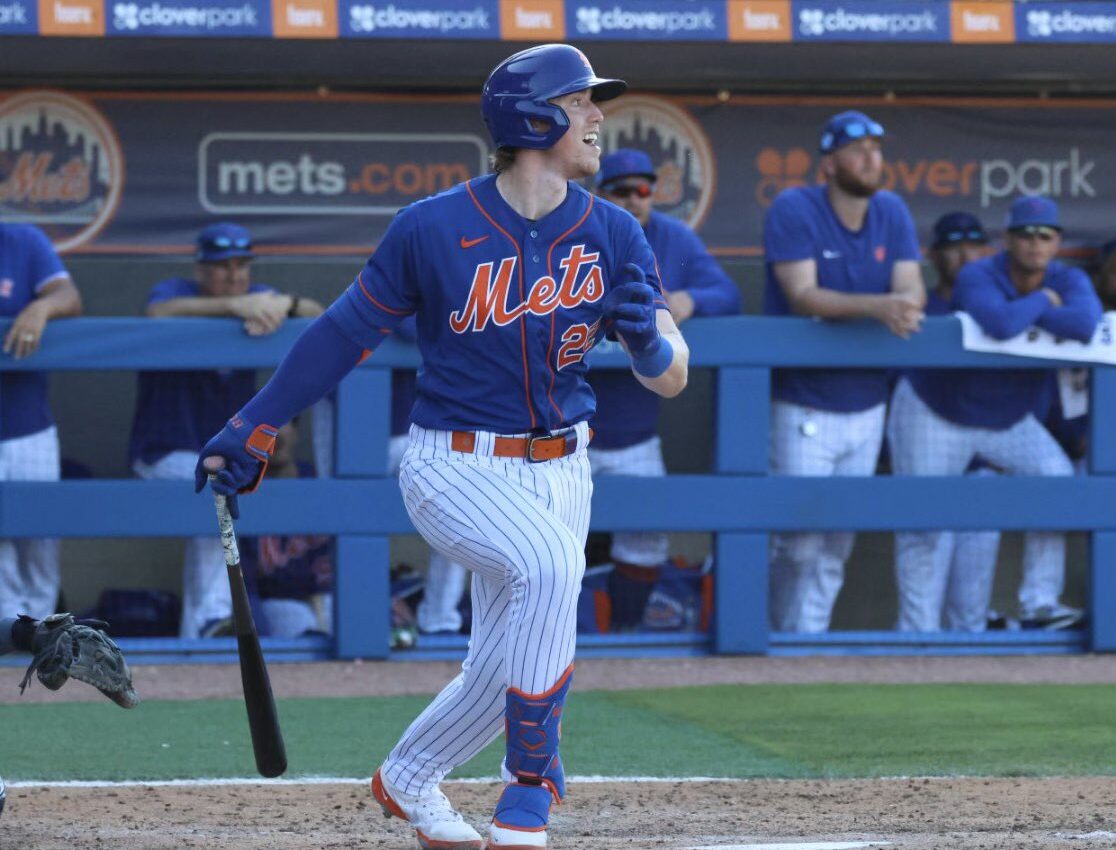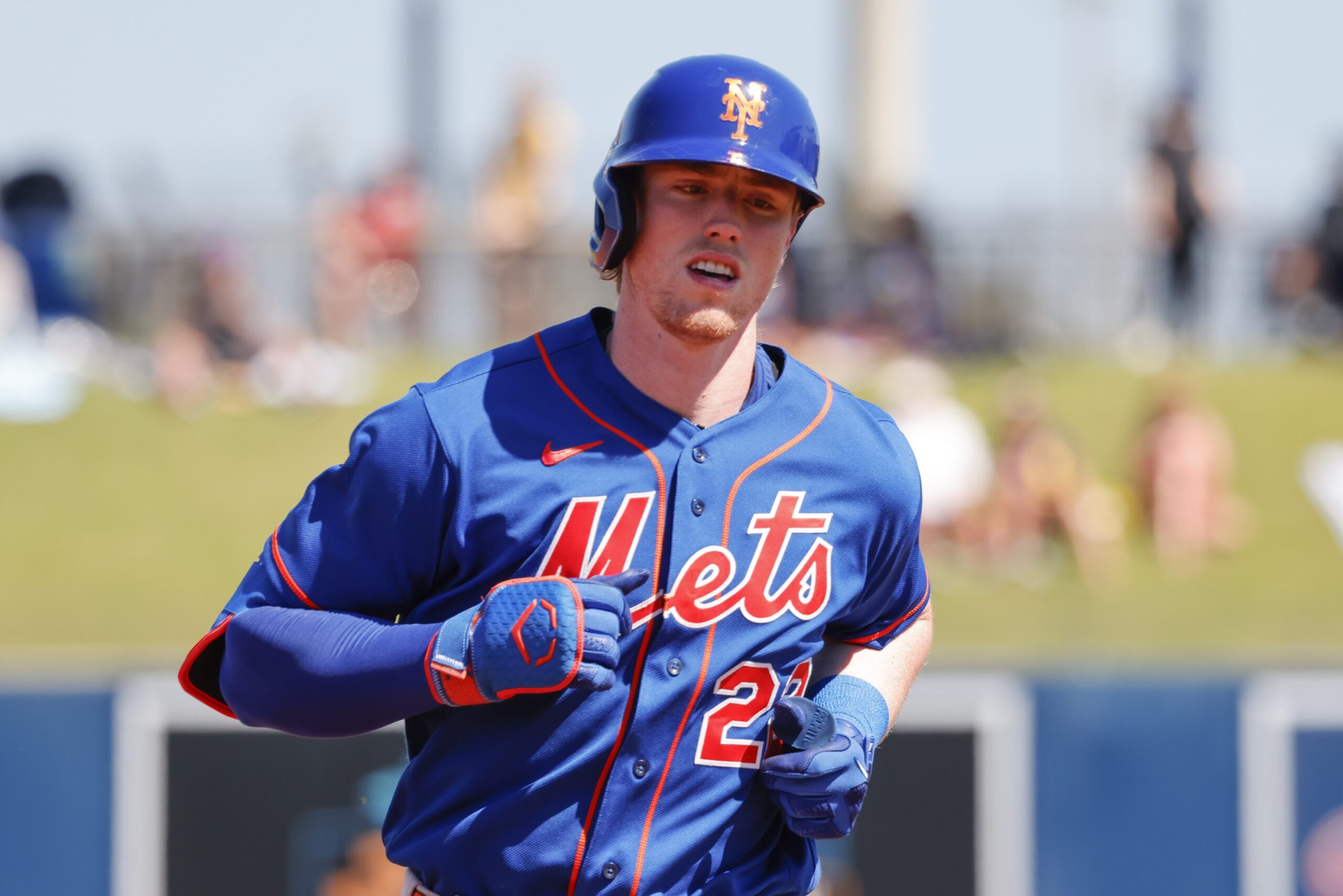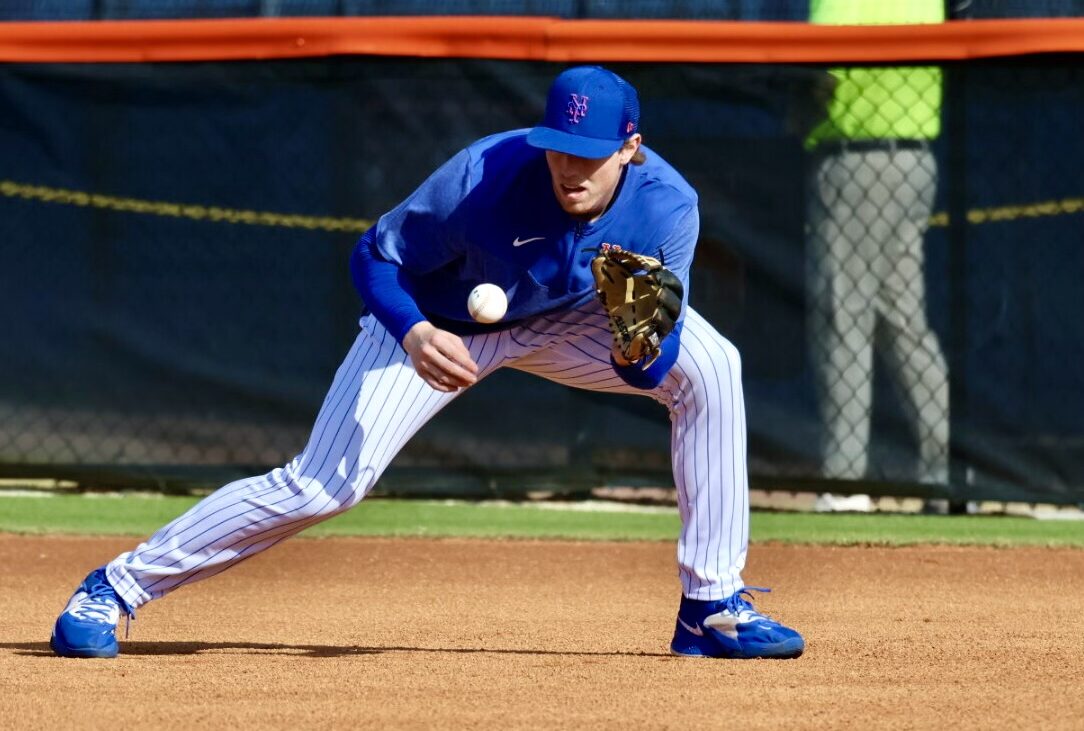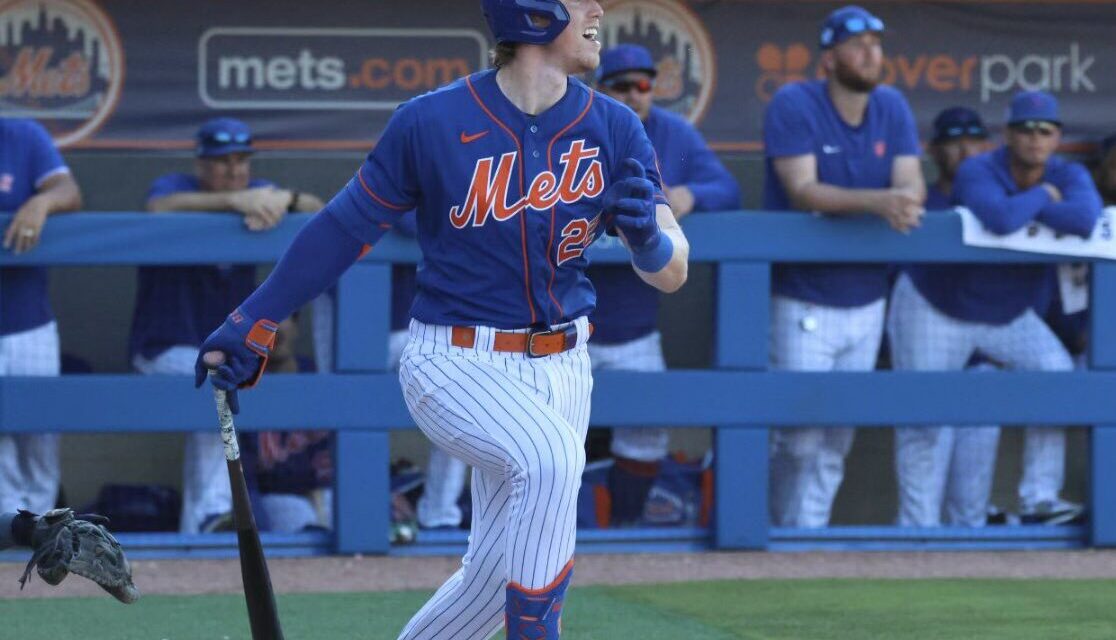
Photo by Ed Delany of Metsmerized
So much for an uphill battle to make the New York Mets’ Opening Day roster.
If there is any justice in baseball, Brett Baty will be the Opening Day third baseman for the Mets in Miami.
Forget sunk costs. Forget rationalizations.
Steve Cohen said it himself: the Mets needed one more piece. Baty has shown that there’s a chance he can be that piece. What more is there to ask?
Hard Hitting
The Mets ranked 21st in the majors in hard-hit rate last season at 37.1%. They tied for 19th in average exit velocity at 88.2 mph.
Meanwhile, one thing that Baty did at every level of the minors and carried to the majors was knocking the cover off the ball. Per Baseball Savant, his average exit velocity over 30 batted balls was 91.1 mph, which is one of the reasons he had an xBA of .287 despite an actual BA of .184.
So far this spring training, Baty has averaged a 93.1 mph exit velocity over 17 balls in play. Despite the small sample size, he’s continued to hit the ball hard. His overall .333/.469/.905 stat line in 39 at-bats is a taste of what he can do.
The Mets need that in their lineup.
Home Run Potential
In general, each time Baty has jumped a level on his way to the majors, it’s taken him a little while to start elevating the ball. This was the case over his cameo with the Mets in 2022 when his 10.0-degree average launch angle was still below the MLB average of 12.1.
Although Baty has not quite gotten there yet in spring training (his average launch angle is 3.2 degrees), the only way he’ll actually be able to improve that is with major league reps, not by continuing to hit in the minors. He’s wasting hitting development time at a level where he’s already proven everything he can.
Yes, Eduardo Escobar hit 20 home runs last year, but eight of them came after September 1. If both players are a gamble to hit their home run potential, the Mets might as well take a swing with the player who’s actually part of their future.
Mashing Righties
The majority of at-bats that any given batter takes will be against right-handed pitchers. Even a lefty like Baty will still see more right-handed starters than southpaws even if teams play matchups later in games.
Escobar is a poor left-handed hitter with depressed power potential from that side of the plate. He hit .231/.294/.387/.681 against righties last season compared to .259/.299/.519/.817 against lefties. Although he was not as poor as a righty batter in 2021, his splits (.752 OPS vs. .877) were still dramatic. For his career, Escobar has a .725 OPS as a left-handed batter, compared to .782 as a righty.
That alone would be a reason to get Baty in the lineup. Escobar provided such little production against right-handers that it’s time to get someone else who can hit them. In Baty’s short major league stint, he had an OPS of .695 against righties compared to .222 against lefties. Although neither stat is good, coupled with Baty’s hard hitting, that likely would have improved over time.

Reinhold Matay-USA TODAY Sports
Deeper Lineup
Whether Escobar or Baty earns the starting third base job, either one will likely bat eighth in the lineup. Though the Mets hope that Escobar rebounds from a mostly poor 2022 season, he’s an aging player on the way down, whereas Baty is more likely to improve.
The power potential that Baty brings can lengthen the Mets’ lineup, giving them more options at the bottom rather than just having two automatic outs there as they had for much of 2022 in Escobar followed by the catcher.
Furthermore, Escobar can still crack the starting lineup against lefties by taking over Darin Ruf‘s DH position. Ruf has struggled mightily this spring and does not seem long for the team. The Mets already have a natural replacement.
Defensive Excuses
The Mets want their prospects to gain more seasoning defensively. With Francisco Álvarez at catcher, it makes sense given the defensive prowess of both Tomás Nido and Omar Narváez. However, Escobar recorded -6 OAA last season at third, ranked in the eighth percentile among all MLB third basemen. Yes, the Mets have Luis Guillorme as a third baseman with an elite glove, but Guillorme’s hitting in the number eight hole is even more futile than Escobar’s was for most of 2022 and offers zero power.
Well ok then. pic.twitter.com/aYw8JjnYM4
— Steve Gelbs (@SteveGelbs) March 14, 2023
Furthermore, Baty seems to have turned it on defensively recently. His work with Troy Tulowitzki and Eric Chávez has done him a lot of good. As our Michael Mayer described, Baty appears a lot more comfortable at third. He’s obviously not there yet, but Escobar is hardly superior at the hot corner right now.

Photo by Ed Delany of Metsmerized
Ceiling
Baty’s ceiling as a hitter is likely 25-30 homer power with plenty of average and on-base potential, as well. Will he reach that as a rookie? While it’s easy to say no, the fact that he hits the ball so hard always makes his expected metrics high. That kind of exit velocity can break out at any time. Baty accelerated through the minors and has shown flashes.
The whole point is that the talent is there and there’s not much more for him to gain in the minors as a hitter. Defensively, he seems to be doing more to improve with the major league coaches than he did with his minor league ones. Other Mets prospects have come up with suspect glove profiles and improved significantly with the big-league club, including Brandon Nimmo and Michael Conforto. Baty can become a competent third baseman this season and only improve from there.
Sunk Costs
The idea that the Mets are tied to Escobar just because they invested money in him is the worst reason to keep Baty in the minors. For all the talk about Cohen’s willingness to spend money, the sunk cost fallacy still seems to be a significant factor in the team’s decision-making. In fact, it is likely the sole reason that Ruf is still on the team.
Yes, the Mets spent $10 million per year on Escobar, but he’d hardly be the first $10 million man to platoon or play on the bench. Either way, he has a team option for the same amount in 2024, and the Mets need to know if Baty is ready to take over. They waited too long to give him time to acclimate last year. It’s foolish to make the same mistake again.
Team-controlled Seasons
When the Wilpons owned the Mets, nary a prospect would ever catch a whiff of the majors if it meant giving up one of the player’s controllable seasons. A “full year” of service is defined as 172 days; therefore, the Mets would promote their top prospects in May and June, making them fall short of a full year. This was classic service-time manipulation.
The Mets wanted to do the same with Pete Alonso in 2019, but he so outperformed Dom Smith in spring training that he forced the team’s hand. They certainly did not regret that decision, as Alonso broke the MLB rookie record with 53 home runs.
Baty follows the same path. The team wants as many years of cheap contracts as possible. They would retain the extra year of control if they wait a bit to elevate him to the big-league club.
However, the CBA agreement last year attempted to incentivize teams to forgo service-time manipulation. This is the language of the Prospect Promotion Incentive:
A team is eligible for Prospect Promotion Incentive (PPI) draft picks if a rookie-eligible player with 60 days or fewer of major league service who is included on a preseason top 100 prospect list by two or more of Baseball America, ESPN.com or MLB.com is promoted and finishes high in award voting in any year before he is eligible for arbitration. The team would get an amateur draft pick for a Rookie of the Year or a top three in MVP or Cy Young, and an international selection if second or third in Rookie of the Year, or fourth or fifth in Cy Young. A team can gain at most one PPI pick in the amateur draft and three total PPI picks for any individual prospect in his career.
In other words, if Baty becomes an award finalist in any of his pre-arbitration years, the Mets would receive draft-pick compensation. It’s not perfect, as players with less than a full year of accrued service can still win Rookie of the Year or other awards, and the Mets would also be eligible if they promoted him next year instead. However, given Cohen’s emphasis on building through the farm system, this would be one potential way to try to earn some extra draft capital, either in the amateur draft or international selections.
Will It Happen?
Will Baty actually crack the Mets’ Opening Day lineup? Prior to spring training, most analysts considered it a longshot, primarily due to Baty’s defensive struggles and the Mets’ affinity for Escobar (and Guillorme). However, Baty’s improvement at third and his strong plate performance have certainly given the team something to think about.
Following the Mets’ track record from last season of slow-playing their prospects, I’m going to guess that Baty begins the season in Triple-A. However, at the first poor performance from Escobar, a slow start for the team offensively, or injury, Baty will be up.















